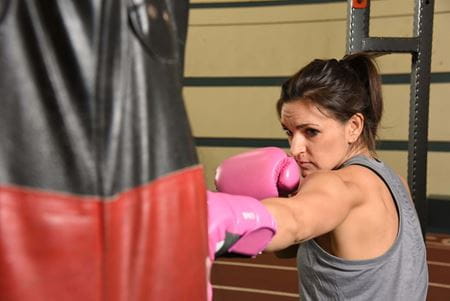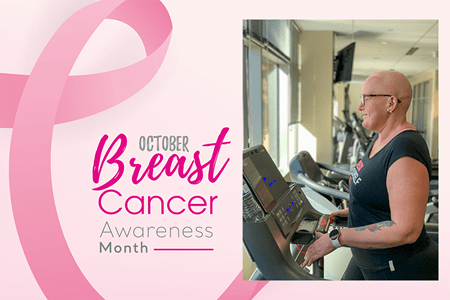No one is ever prepared for the disruption a breast cancer diagnosis brings. Jen Hedges, a 41-year-old executive with a property management company, knew chemotherapy would be brutal. She knew she would be tired, but the extremity of her exhaustion coupled with rapid weight gain left her feeling defeated.
When her nurse navigator mentioned a new exercise therapy program for breast cancer patients at the Indiana University Melvin and Bren Simon Comprehensive Cancer Center, she didn’t hesitate.
“The exhaustion that is experienced through the chemotherapy process is tough to combat, and I was ready for a change,” said Hedges, who describes herself as “active” before her diagnosis with Stage 3 breast cancer in May 2022. “I have a long road to go to get my body back in the best shape, but I am so glad the MOVE program is there to support me. I need the extra motivation and someone that can help me understand the ‘starting over’ process.”
 The Multidisciplinary Oncology Vitality and Exercise (MOVE) Program, developed by oncologist Tarah Ballinger, MD, gives cancer patients a personalized plan for exercise and physical therapy throughout all stages of their cancer journey.
The Multidisciplinary Oncology Vitality and Exercise (MOVE) Program, developed by oncologist Tarah Ballinger, MD, gives cancer patients a personalized plan for exercise and physical therapy throughout all stages of their cancer journey.
“Exercise works better than any medications to treat cancer-related fatigue,” said Ballinger, an assistant professor of clinical medicine at IU School of Medicine and the Vera Bradley Foundation Scholar in Breast Cancer Research. “It reduces the effects of cancer on both physical and mental health. It prevents the degradation of muscle that occurs during treatment, and exercise helps regulate our immune system.”
The bottom line: “Exercise is important for quality of life and survival after cancer.”
Helping survivors get stronger
For years, breast cancer patients were told to “take it easy” through surgeries, chemotherapy and radiation. Turns out, that advice was wrong. Recent studies prove exercise during cancer treatment reduces negative side effects, improves mood and accelerates healing.
“In practice seeing cancer patients, a common question is what patients can do for themselves to improve how they’re feeling,” said Ballinger, a pioneer in the emerging field of exercise oncology and a researcher at the IU Simon Comprehensive Cancer Center. “Patients wanted advice on exercise and fitness, and we didn’t have a lot of answers. It was a big gap in the care we were providing.”
 Ballinger conducted a survey of cancer center patients to determine their level of awareness and desire for physical activity and exercise support.
Ballinger conducted a survey of cancer center patients to determine their level of awareness and desire for physical activity and exercise support.
“Most patients said they didn’t have the opportunity to discuss exercise or fitness with their care providers and weren’t given specific instructions—but they wanted to be,” Ballinger found. “Since different patients need different levels of support, it needs to be personalized. The best way to do this is precision medicine.”
The cancer center piloted the MOVE program with 30 breast cancer patients in February 2022 and later expanded it to include esophageal cancer patients before opening the program for all types of cancers.
Nearly 50 patients have acted on referrals from their oncology teams since August. One patient from a different health system transferred care specifically to gain access to the MOVE program, which is offered free to all cancer center patients, Ballinger noted.
“Our breast cancer population is particularly excited about the program,” said Danielle Halsey, MS, lead exercise physiologist with MOVE. “It’s fun to see them after one or two weeks, feeling stronger and more confident in doing daily tasks such as going up and down stairs without feeling fatigued.”
Hedges, who has gone through eight rounds of chemotherapy and is scheduled for a double mastectomy this month, completes weekly workouts directed by Halsey and does physical therapy with Bryce Showers, the cancer center’s first oncology-certified physical therapist.
“I am less tired, I have more confidence in myself, and I have the desire back to push myself to maximize in all areas to get my health in its best possible shape,” Hedges said. “I am extremely grateful this program exists.”
 Breast cancer survivor Janai Mitchell, 27, completes her final chemotherapy treatment in early October and has seen Halsey and Showers for exercise and physical therapy following each round. As an athlete, Mitchell was eager to join the pilot program for MOVE and provide her feedback.
Breast cancer survivor Janai Mitchell, 27, completes her final chemotherapy treatment in early October and has seen Halsey and Showers for exercise and physical therapy following each round. As an athlete, Mitchell was eager to join the pilot program for MOVE and provide her feedback.
“I think it gets my mind off of what I’m going through and has taken away the fatigue I would otherwise get from the chemo,” Mitchell said. “It has helped me physically and mentally to have Bryce and Dani supporting me, telling me I’m doing great and that they’re seeing progress.”
Breast cancer patients often benefit from strengthening exercises for their chest and back muscles following surgeries, Halsey said. They also frequently deal with lymphedema, a swelling of the arm on the side where lymph nodes have been removed, and chemotherapy-induced neuropathy, which causes pain or numbness in the hands and feet.
“We used to think exercise would make lymphedema worse, but what we’ve proved is actually the opposite,” Ballinger said. “Progressive weightlifting for a year after breast surgery reduces the incidence of developing lymphedema by 75 percent.”
 Halsey, who has worked in exercise oncology since her undergraduate studies, vividly recalls the moment her first breast cancer patient, two months post-mastectomy, graduated from 2-pound to 5-pound weights.
Halsey, who has worked in exercise oncology since her undergraduate studies, vividly recalls the moment her first breast cancer patient, two months post-mastectomy, graduated from 2-pound to 5-pound weights.
“It was the most exciting thing in the world for her,” Halsey said. “There was this switch and a new sense of confidence. It was a feeling of, ‘I can do this, I am strong, I am capable.’ That is my favorite moment—when they regain that piece of themselves.”
Along with physical side effects of treatment, breast cancer survivors often experience anxiety and depression stemming from the loss of control over their life and health, Ballinger noted.
“The MOVE program helps them feel more empowered,” she said. “We might be helping them exercise or move more or push through chemotherapy, but they’re the ones doing the work. Doing something like this helps them feel more confident and capable about what they can do. For me, that’s the biggest motivator.”
Expanding exercise oncology care
A former club boxer in college and a life-long athlete, Ballinger wears pink boxing gloves to pummel a training bag at her home—a visual reminder of her continual fight to improve the lives of her patients as they “knock out” breast cancer together.
 In recent decades, cancer treatments have improved so cancer survivors are living longer. While that’s good news, it means more people are living with the adverse side effects of cancer treatments, Ballinger noted. Those who exercise have better long-term prognoses.
In recent decades, cancer treatments have improved so cancer survivors are living longer. While that’s good news, it means more people are living with the adverse side effects of cancer treatments, Ballinger noted. Those who exercise have better long-term prognoses.
“Higher levels of activity after cancer diagnosis are associated with a 38-percent reduction in cancer-specific death in breast cancer,” Ballinger said. “We spend billions of dollars to develop drugs, but exercise is freely available. We need to use our resources to help patients take advantage of its benefits.”
The IU Simon Comprehensive Cancer Center is making it easy for patients to “fill” their prescription for exercise by giving them individualized exercise plans which evolve throughout the cancer journey.
The program works for every stage of cancer, from initial diagnosis all the way to metastatic disease, Ballinger said. She’s currently collecting data on the benefits of physical activity and exercise in late-stage cancer.
“The MOVE program is not just delivering a clinical service but also helping in research studies across the cancer center,” Ballinger added. “The grand vision is for this to be integrated into the plan of care for every patient who is going through cancer treatment.”
